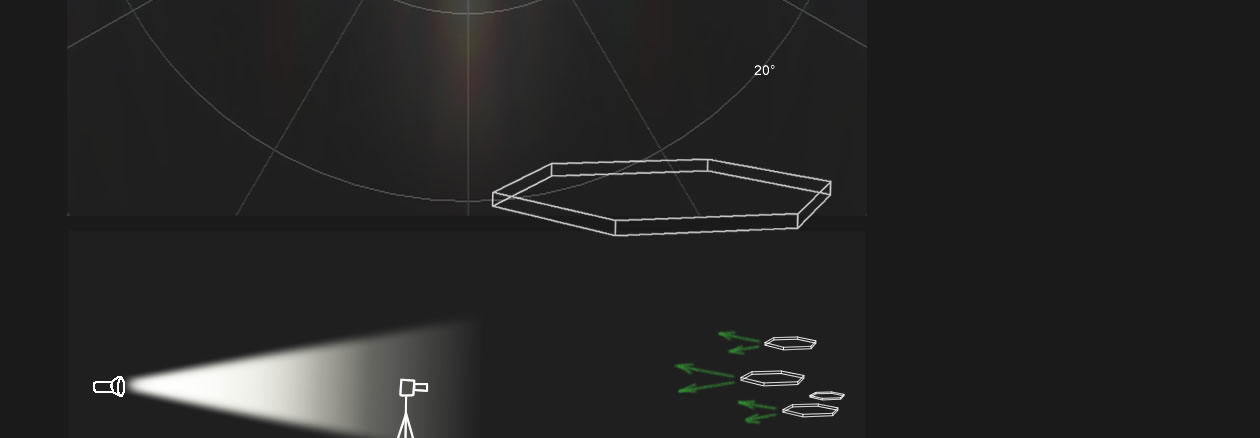|
||||
 |
||||
|
| Mystery Pillar Marko Mikkilä (halo gallery), who first photographed the Kern arc, discovered this previously unnoticed colour fringed pillar. He was hunting halos at Sievi in Finland on 9th January ‘12. The minus 15 Celsius air was thick with diamond dust crystals. Marko hunted at night, replacing the sun with a bright halogen lamp. That way halos and other phenomena show up against the dark sky better than in daylight. The pillar has since been found on pre-discovery images taken by Miko Aho, �gnes Kiricsi and Marko Riikonen. It is real. ©Marko Mikkilä, shown with permission |
|
||||
 |
||||
|

| About - Submit | Optics Picture of the Day | Galleries | Previous | Next | Today |
| The backscattered diffraction pillar in the direction looking away from the lamp. Each side has a coloured fringe. Looking towards the lamp there is a conventional pillar produced by plate crystals reflecting lamp rays from their large upper and lower hexagonal facets. The pillar shows no colour other than that of the lamp. "Lampdogs" are to the left and right of the lamp position. |
| Oriented plate crystals diffract light back towards the light source to produce the pillar |
| What is it? Halo experts were puzzled. Ordinary pillars, glints from plate or column ice crystals, are immediately above and below the sun (or lamp, see one at page bottom). The new pillar is opposite the sun/lamp in the direction to which shadows converge. It is unlikely to be an ice halo produced by refraction and reflection because it cannot be reproduced in ray tracing simulations using known crystal forms and orientations. That, of course, is not definite proof because some halos still await explanation. Important clues to its origin were the faint colour fringes at the pillar sides and its location opposite the lamp/sun where colourful glories shine. They suggest a diffraction backscattering effect like the glory, in fact the apparition - a pillar flaming upwards from the shadow of Marko's head - reminds us of a Brocken Spectre shadow and its surrounding glory. The problem with a diffraction mechanism is the pillar�s shape. Small non-spherical objects, pollen grains, ice crystals produce non-circular diffraction patterns but not elongated to this extent nor opposite the sun. Nonetheless, from halos also visible at the time it seemed that hexagonal plate crystals might be the culprits. The next challenge was to test this possibility. Not easy because of plate crystals� non-spherical geometry. Then Nicolas Lefaudeux from France stepped in and applied Finite Difference Time Domain (FDTD) computations, a modern technique used, for example, to compute scattering by complex photonic crystals. FDTD is a brute force time-wise integration of Maxwell's equations, the fundamental equations of electromagnetism. The finite difference method has to employ a computational mesh small enough to describe light waves yet also encompass the scattering crystal enormous by comparison. Computer demands are therefore huge. The calculations quite naturally incorporate refraction, diffraction, surface waves and so on. They can accurately predict what we see in our macro world. But we always want more! We like high level, easy to visualise, mechanistic explanations of what is happening. Like earlier Mie-Lorenz theory, FDTD provides no such comfort. The story of the glory repeats itself. Nicolas Lefaudeux performed calculations for backscattering by plate oriented crystals. At left is an example for plates 32 micron across and 2.5 micron thick. The 5° high pillar with colour fringes is similar to that observed. Refinements of the model, particularly use of larger but thin crystals, are expected to further improve the match. The new pillar is therefore almost certainly a backscattering effect from oriented hexagonal plate crystals. It has been tentatively named a 'subanthelic diffraction pillar'. Hamlet: ".. And therefore as a stranger give it welcome. There are more things in heaven and earth, Horatio, than are dreamt of in your philosophy." May we see more sky sights we have yet undreamed of. |
| A very bright lamp replaces the sun. Halos and other atmospheric optics show up better against a dark sky. |
| Top: Enhanced image to show colour fringes Right: FTDT simulation by Nicolas Lefaudeux of backscattering by thin hexagonal plate crystals. Unlike a conventional reflection/refraction pillar, the crystals need not be tilted. Their extended horizontal profile produces a vertically elongated diffraction pattern. |